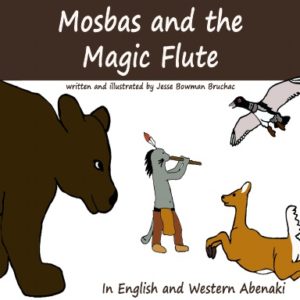Overview
This lesson uses Jesse Bruchac’s picture book, Mosbas and the Magic Flute, Marge Bruchac’s Malian’s Song, and a visualization reading tool where students write down what they “see,” “hear,” “smell,” “taste,” and “feel.” The tool provides a springboard for a discussion of both the stories themselves and the role of stories in Abenaki culture.
Focusing Question
What are the roles of stories in Abenaki culture?
Topical Understandings
Stories provided life lessons for their listeners.
Stories were passed down through the generations as a form of oral history.
Background Information

Mosbas and the Magic Flute is written in both English and Abenaki and provides an example of how some stories provide life lessons in Abenaki culture. In the story, Mosbas was far too shy to speak to girls. When he is given a magic flute, he finds its power too much to control and is eventually changed forever.
Malian’s Song is an example of a story passed down through the generations. In the words of a young Abenaki girl, the book tells the true story of the deliberate English attack by British Major Robert Rogers on the St. Francis Abenaki community near Montréal in 1759. Jeanne Brink, a descendant of Malian living in Vermont, told the little-known Abenaki version of the brutal attack–which stands in direct contrast to Rogers’ surviving journal records–to the Vermont Folklife Center. The only picture book to present this key piece of North American history from the Native American perspective, Malian’s Song underscores the Abenaki people’s strength and fortitude in the face of unspeakable loss.
This story began in 1759 and has only been passed along 4 times. That is because it was a story that was deliberately told from Grandmother to youngest grandaughter as a key piece of history.
Materials
Jesse Bruchac, Mosbas and the Magic Flute
Marge Bruchac, Malian’s Song
Visualization Tool
Procedures
1. Stories for teaching about morals and behavior
Hand out the Visualization Tool and have students fill it out as you read them “Mosbas and the Magic Flute.” Talk about what they see, hear, smell, and feel. Talk about the lesson of the story.
2. Stories for keeping history
-
-
- Have you ever played the telephone game with your class? Give it a try with this sentence:
-
“A blue bird is sitting on eggs in her nest.” First write down the sentence, then pass the word around. Walt Garner, middle school teacher at Tunbridge, VT, has used this game as a way to introduce to students the idea that stories passed down through the generations can remain accurate.
Read the class Malian’s Song and explain that it is a story handed down through the generations. It is a way the Abenaki keep their history and it is one role of stories in their culture.
Listen to Elvine Obomsawin Royce tell this story online at the Vermont Folklife Center.
3. Compare the two stories.
Why is each story told? Why is each story important?